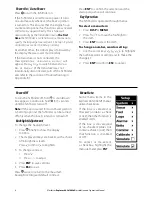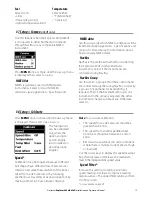
Shadows
Shadows are created around areas where the ultrasonic beam cannot ‘see’. These areas include hollows
on the bottom or beside rocks and ledges, where the strong echoes returned off the rocks obscure the
weak echoes of the fish and may also create a double bottom trace. See following for an example of the
sonar display in such an environment. A double bottom trace is shown on the display.
When looking for fish with the wide angled 83 kHz frequency, be aware of increased shadows. Use the
high frequency 200 kHz in areas that have rocks and ledges because this frequency reduces the shadow
effect considerably.
The differences in the cone width affect what is displayed. See section 4-2 Single and Dual Frequency fishfinding.
Frequency and cone width
The pulse generated by the Explorer 443d/443df
transducer travels down through the water,
spreading outwards to form a rough cone shape.
However, the cone width is dependent upon the
frequency of the pulse; at 83 kHz it is 20°, whereas
at 200 kHz it is 14°. The chart shows how the cone
width varies over depth for each frequency used.
Figures are approximate.
Water
Cone width
Cone width
Depth
at 83 kHz
at 200 kHz
10
4
2
20
7
5
30
11
7
40
15
10
50
18
12
60
22
15
70
25
17
80
29
20
90
33
22
100
36
25
150
55
37
200
73
50
300
109
75
400
146
100
500
182
125
600
218
149
700
255
174
800
291
199
900
328
224
1000
364
249
Depth 83
kHz
200
kHz
20°
14°
50
100
150
200
250
0
18
30
55
73
91
12
25
37
50
62
Sonar display of same area
Fish is visible on the display
Fish is hidden by the strong echoes off the
bottom and is not shown on the display
Example of shadows
Fish is visible on the display
Northstar
Explorer 443d/443df
Installation and Operation Manual
18
Summary of Contents for EXPLORER 443D
Page 1: ...www northstarnav com Explorer 443d 443df Fishfinder Installation and Operation Manual ...
Page 2: ......
Page 39: ......



































